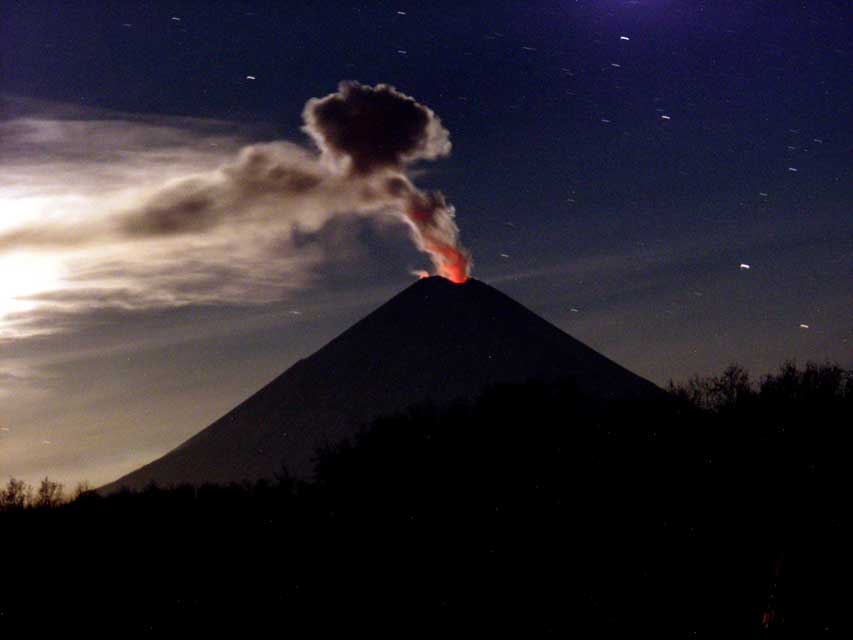~
Kamchatka
~

The october 2003 eruption of Klyuchevskoi volcano. [Yuri Demyanchuk]
go to:
Introduction
Kamchatka is a huge peninsula between the sea of Okhotsk, the Bering sea and
the Pacific Ocean in Russia's far east. The peninsula is for the major part
uninhabited. There are three cities (Petropavlovsk-Kamchatski, Elizovo and
Vilyuchinsk) and about 40 tiny villages, often not more than one or two
apartmentblocks and a few wooden houses in the middle of nowhere. The rest of
Kamchatka is just the plain beauty of the stunning nature and rugged terrain.
geology
The geology of Kamchatka is ruled by one important geological phenomenon, the
subduction zone. The Pacific plate is forced underneath the Eurasian plate. This
causes the formation of volcanoes and mountains, in effect the entire peninsula.
It is therefore no suprise that Kamchatka consists of volcanic rocks like
andesite, dacite, rhyolite and basalt. All active volcanoes are today situated
along the eastern zone of the peninsula. The Srednyi Khebret, or Central Range
is a mountainrange running across the axis of the peninsula. no active volcanoes
can be found in this range, many extinc volcanoes can.
Mineralogy on volcanoes is often very complex. The magma generally cools down too quickly for the formation of reasonable crystals. Most interesting mineralogy on volcanoes come either from xenoliths or from fumarol activity. Xenoliths like those known from the Eifel where formed when magma travels through a layer of a different rock, like for instance limestone. Chunks of limestone break off and travel outwards with the magma. During this proces the heat and chemistry of the magma changes the mineralogy of the limestone. Since Kamchatka consists of virtually only volcanic rocks, there will be no spectacular xenoliths. This leaves the fumarol as most important volcanic mineral source. And for this life is good on Kamchatka. The Pacific plate pulls down lots of sediments and seawater down into the magma. All this will be converted to gas. Apart from nasty violent eruptions the gas also causes interesting fumaroles. Most famous are the fumaroles of Tolbachik volcano. Here very rare copper mineralogy is found in the fumaroles. Apart from Tolbachik there are many more volcanoes with interesting fumarol mineralogy.
Kamchatka might be best known for Tolbachik's fumarols there are a great number of very interesting localities or potential localities on Kamchatka. I'm very interested in the hydrothermal veins scattered across the peninsula. Many Kamchatkans visit a natural hotspring in the weekend and soak all day in a smelly sulpherous hot water spring. These springs are everywhere, most famous resorts are around Paratunka, Termalnye and Malki, but there are hundreds of such springs out in the bush. The water is of course heated by the magmachambers underneath and many pools are brown from iron oxides. So we have hot water and the presence of chemical elements like iron, gold, silver, copper zinc lead etc. This should form potentially interesting vein deposits. First indications are that there are such deposits around. I found some names like Paratunka mentioned in connections with hydrothermal vein deposits and while sniffing around in the piles of collected material at the IVGG (Institute of Volcanology Geology and Geochemistry) I saw some typical hydrothermal samples with massive chalcopyrite and galena. On my next visit to Kamchatka I will try to locate some of these veins and see if there is any collectible material. It won't be an easy task and will involve long walks through the dense taiga.
carefull
I'm not the person to guard over your collecting activities, but a small
word of caution is on it's place. Kamchatka is a great country, but it is
serious nature. Every year people get killed because they do not take nature
seriously. Climbing volcanoes can be dangerous because they consist of loose
slippery material. I know experienced alpinists got killed climbing Koryaky
volcano. In fumarol fields collectors got overcome by the toxic fumes and others
fall through thin crusty roofs of lava chambers. The weather can change pretty
quickly from bright blue skies to dense fog within 30 minutes. And finally of
course the bears. Kamchatkan bears are the biggest around. Incidently people get
attacked or killed by bears. Usually they behave quit friendly, but make no
mistakes they are wild animals and they definitely attack when they get in
trouble. Rockhounds are not on the menu of the bear, so they won't hunt you. It
is just the misfortunate 'being on the wrong place at the wrong time' that
gets you in trouble. At the same time seeing huge wild Kamchatkan bears as a
close as about 50 meters is one of the best and most impressive experiences I
ever had. That time I was with Russia's most famous and experienced bear watcher
Vitaly Nikolaenko. Sadly only 6 months after Vitaly was killed by a Kamchatkan
bear.